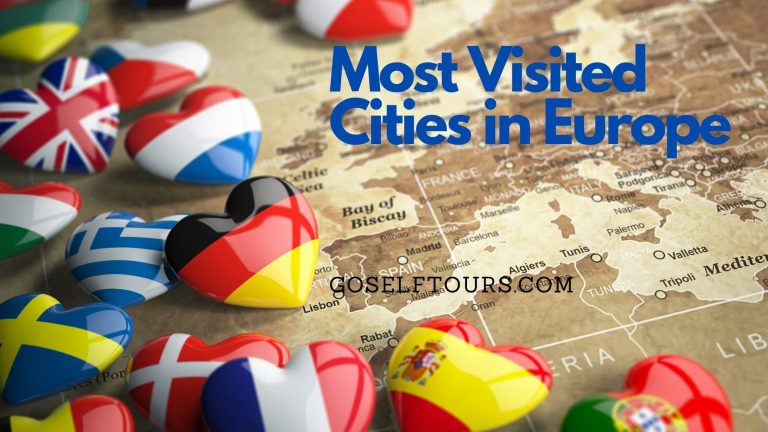10 Best Things to Do in Amsterdam
Amsterdam has always been one of the most popular destinations for tourists from all over the world who find art, architecture, and entertainment here, as well as beautiful alleys and squares, to discover, perhaps with a pleasant bike ride.
A trip to the capital of the Netherlands is a unique experience in which the charm of history and the curiosity of modernity are harmoniously intertwined. Among alleys and canals, coffee shops, and museums, here are 10 things to see absolutely in Amsterdam.
Amsterdam Canal Cruises

You can’t get to know Amsterdam except by taking a tour of the canals, which cross the entire historic center thanks to the canal belt, a wide ring of water that in 2010 was listed by UNESCO as a World Heritage Site.
Without any doubt, the best way to visit these areas is by a romantic boat cruise. There are several alternatives and possibilities: from the combined tour bus + boat excursion to the classic night cruise on the canals, or even the cruise with dinner on board, available in double version, low cost (based on hamburgers and drinks) or high budget (4-course dinner).
If, on the other hand, you’re taking a low-cost, low-budget trip, a fascinating alternative is to explore the canals on foot or perhaps by bicycle, a means particularly used in the Dutch city.
Practical info: directions, timetables, and prices
How to get there: the historical center. On foot, by bicycle
Hours: always open
Ticket cost: from €11.00 on average for a simple boat ride
Card, ticket, and recommended tours: canal cruise with guide
Move on your bike:
If you intend to take part in a bike tour or rent a vehicle to move independently, follow these rules: stay on the bike lanes and never go on the sidewalks, stay on the right side of the road, use your arms to signal in which direction you are turning and above all follow the traffic lights (Amsterdam has special traffic lights for cyclists). If you see an inverted triangle, give way to pedestrians.
Van Gogh Museum

An important and famous museum in Amsterdam, the Van Gogh Museum houses the largest collection of works by the Dutch painter. In addition to his works (over 500), the museum also houses works by his younger brother Theo and other well-known French artists. Van Gogh’s letters to his brother and some of the famous painter’s personal belongings are fascinating. You really cannot miss a visit to this building on a Dutch trip.
The Van Gogh Museum is a must, one of the most visited attractions in the whole city. For this reason, it is recommended that you buy your ticket with priority admission in advance to avoid being stuck in line for a long time.
Practical info: directions, timetables, and prices
Take the document with you:
If you don’t want to risk a fine, remember always to carry your ID (Identity Card for EU citizens, alternatively Passport). You will be asked to show your ID at the entrance to different venues and sometimes museums (you will certainly have to do this to access a coffee shop).
Royal Palace

Still used today by the royal family, this palace was built about 350 years ago as Town Hall and is an example of Dutch Baroque architecture. Its function as a palace dates back to 1808, thanks to Napoleon Bonaparte. Inside the palace is definitely worth visiting the museum that tells the city’s history and the country.
Also, in this case, it is preferable to buy the ticket with priority entrance, which also includes the audio guide for the independent visit of the Palace.
Dam Square
Called the Dam, this square is one of the most loved by Amsterdam residents and tourists alike. It is a perfect blend of history and the modern image of the city. The tram and car traffic divide the square into two parts. Visit the Royal Palace and the National Monument, the 22-meter stone obelisk built in 1956 and dedicated to the Second World War’s fall.
A great way to enjoy the dynamic atmosphere of the square is to take part in a fun guided bike tour that touches all the topical points of the historic center.
Practical info: directions, timetables, and prices
Stedelijk Museum
The Stedelijk is the museum of modern art and design, one of the most important countries. It houses famous works of modern art by the likes of Picasso and Chagall. It boasts one of the most significant collections globally, consisting of no less than 90,000 objects created from 1870 to the present day.
The museum offers several interesting activities and workshops for families and a beautiful panoramic restaurant (accessible without a muzzle ticket).
As with other museums in the city, the Stedelijk Museum is also worth buying an online queue skip ticket before your departure to avoid queues at the entrance.
Practical information: directions, timetables, and prices
Rijksmuseum
Rijksmuseum is one of the most famous museums in Amsterdam and the most important of Dutch art. It houses works by Rembrandt and Vermeer, but not only. From painting to sculpture, from applied arts to prints, in this building, there are over 5 thousand paintings, 30 thousand sculptures, 1 million prints and drawings, works that absolutely deserve a visit if we are in Amsterdam.
If you are planning a short stay in the city of Amsterdam, you will certainly need to optimize your time. Therefore, consider buying a priority entrance ticket.
Practical information: directions, timetables, and prices
Buy a Souvenir:
If you want to buy a souvenir of your trip, do not go to the tourist areas. Rather, you’ll find unique and interesting souvenirs at 9 Straatjes, a lovely area full of pretty boutiques.
Anne Frank House
In the heart of the city, the Anne Frank House is definitely worth a visit. It is the original apartment where the little 13-year-old girl lived the worst days of her life, those that forced her to hide from the Nazi persecution. In this very suggestive place, the sweet little girl wrote her famous diary translated into 65 languages, which has become one of the most important testimonies of the Holocaust.
Through a visit to the house/museum, it is possible to learn how the refugees lived here, discover the history of Anne Frank’s diary and visit some temporary exhibitions on fascism and persecution.
Amsterdam Red light district
In addition to the well-known Coffee Shops, where you can smoke and legally consume marijuana and hashish products, there is a place in the city that has helped establish Amsterdam as one of the most progressive in Europe and the world. We are, of course, talking about the Red Light District.
The Rossebuurt, as it is called in the city, takes its name from the neon windows where women pose, precisely since 1400, waiting for customers. According to estimates today, there are more than 25 thousand and come from every country in the world. In the heart of the center of Amsterdam, here lies the free and unconventional soul of the city.
The district is also called De Wallen and covers over 6 thousand square meters, including three different areas: the Walletjes, the oldest area, Singel, which goes from the station to the Raadhuistraat, and finally Pijp, which develops near the Rijkmuseum. Of course, the district has a particular charm and deserves to be visited beyond why it is generally frequented. It is no coincidence that there are several guided walking tours available to learn about its history and numerous curiosities.
The Oude Kerk ( The Old Church )
Oude Kerk (Old Church) is one of the most famous buildings in Amsterdam, probably its symbol. It was built in 1200 as a Catholic church, and today it has become a building of the Protestant faith. Located practically in the heart of De Wallen, which is the oldest part of the quarter.
The church has been restored many times over the years. The church is located in the cobbled Oudekerksplein square, but one of the most beautiful spots from which to admire it is the adjacent Oudezijds Voorburgwal canal, from which you can enjoy a breathtaking perspective.
Jordaan District in Amsterdam
Quartier of artists par excellence, it was built in the 17th century as a working-class residential area.
Artists’ Quarter par excellence was built in the 17th century as a working-class residential area. It is called the Latin Quarter because of its strong Spanish, French, and Jewish presence. Today, in addition to hosting many artists, it is also the preferred area for students due to the prices of housing that are not too high compared to other city neighborhoods.
Beyond the bohemian charm, the neighborhood is worth a visit for the presence of some interesting attractions, such as the already mentioned Anne Frank House, or the Theo Thijssen Museum, the last house of Rembrandt, and especially the Café Nol, a characteristic place that offers live music in a typically Dutch atmosphere.



